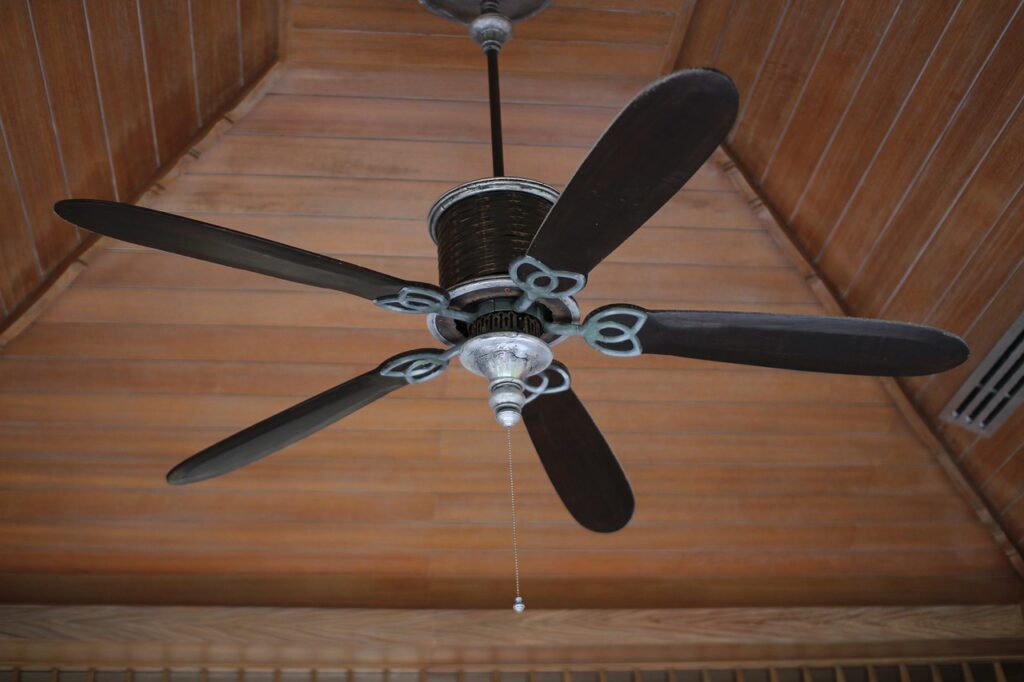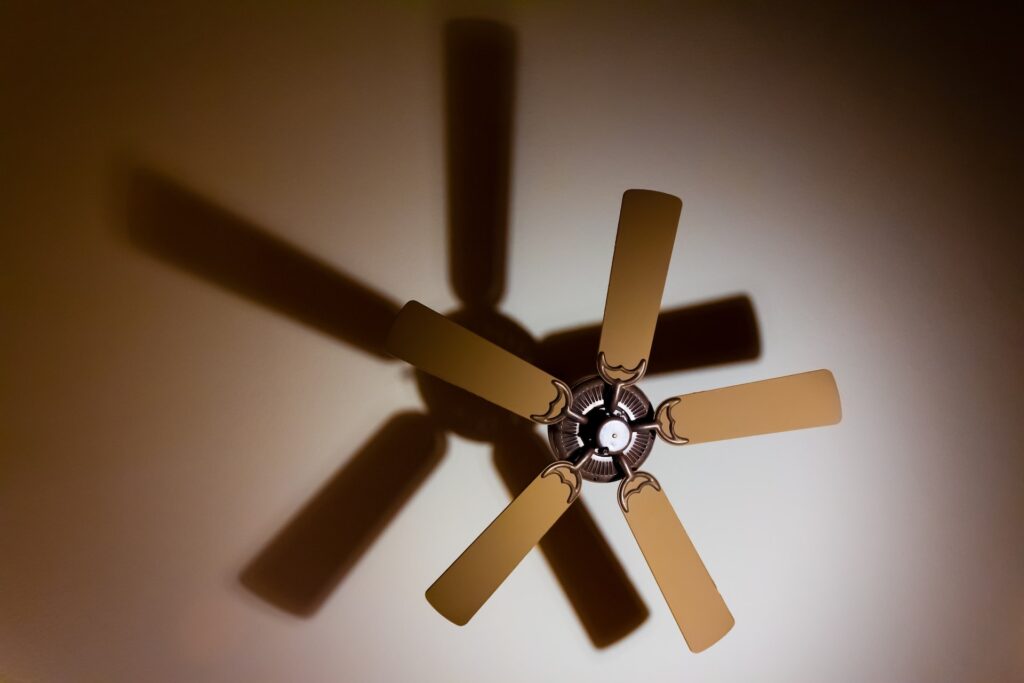Ceiling Fan Making Noise – How to Fix the Problem

A home is a place for comfort, where we can calm down our senses and rest. But serenity might be harder to achieve when your fan is making noises. The optimal situation is when a ceiling fan works almost soundlessly, and if that’s not the case, it might be worth taking a closer look.
Fortunately, most ceiling fan problems have an easy fix, and you can quickly come back to enjoying the light breeze from the fan without any disturbing noises. You can conduct most of the repairs yourself and with almost zero costs. Here are some of the most common fan issues and how to amend them.
Why Is My Ceiling Fan Making Noise?
What to do when a ceiling fan makes noise? There are several reasons why a ceiling fan may produce noise, so the first thing you should do is try to identify the type of noise the device is making and its source.
Rattling Noise
If the sound coming from the fan is a rattling noise, the most likely cause of it is one of the parts is loose. This is often a screw or other small part that gets stuck in the wrong place and makes noise when the fan is in motion. Look for detached screws in the light fixture or possibly a piece of glass, and remove it. Screw all the loose screws.
The other common cause of rattling noise is loose or poorly installed brackets. In this scenario, it might be necessary to change the fan brace altogether.
Clicking Noise
If you hear your ceiling fan clicking, it’s usually related to the fan’s blades getting loose. And for that, you only need a proper screwdriver. You should tighten the loose screws and check if the blades don’t move up and down. You may also check the light fixture screws as well, making sure everything is attached adequately.
Grinding Noise
Grinding ceiling fan noise, although unpleasant or even disturbing, can also be easily amended. First of all, you should eliminate the possibility of fan blades being unbalanced. Check if they are wobbly or if there is any other circumstance that causes them not to be properly aligned.
The second possibility is that your fan’s motor and bearings need to be oiled. Some models have a closed-off cover, which does not allow you to add oil to the motorized parts. If that’s the case, you should book an appointment with an electrician or technician who will be able to carry out the maintenance of the fan safely.
However, if the manual says you can add the oil yourself, you can attempt it. The first step is to check the oil level. To do so, locate the oil fill opening, which can be found near the downrod. Open it and insert a small pipe cleaner. Remove the pipe cleaner and see if it’s covered in oil or lubricant. If it’s mostly dry, this indicates the oil needs to be refilled.
Remember that you should use an oil or a lubricant approved by the manufacturer to avoid damaging the mechanics of the fan. Refill the oil and let it settle for a couple of minutes. Clean any access and spill, and then run the fan to check if the noise still appears.
If so, you may want to consider getting in touch with a technician or buying a new fan.

Humming Noise
If it’s the humming noise you hear when your fan is on, it might be connected to electric issues, usually regarding the ceiling fan remote system or the light switch. It’s best to hire an electrician or HVAC specialist in order to fix the problem, as trying to do so yourself may be dangerous.
How to Stop a Ceiling Fan From Making Noise?
We’ve covered the most common reasons why a ceiling fan may not work correctly and make strange noises. It’s vital to first identify the issue because this way, you can choose the best approach and estimate how complicated and potentially costly the repair will be.
Now we will talk about the most common and effective ways to address the noise coming from a fan. Here’s how to fix a noisy ceiling fan.
Clean it
Sometimes, the simplest answers are the right ones. Dust accumulating on the fan’s blades may cause them to loosen and wobble, which may lead to the ceiling fan making noise. And the solution to that is wiping the fan and blades with a piece of material that is a bit damp. Regular cleaning will help you reduce potential issues with a fan.
Screw the Loose Parts
It’s normal that appliances that are often in motion can have some loose parts. You should pay attention to all the screws, the blades and the light kit, ensuring they are correctly tightened and don’t make any unwanted movements.
Check the Fan Canopy
The same should be applied to the fan canopy. Check if it’s properly attached to the fan and if you notice any issues, tighten the screws.
Balance a Ceiling Fan
If your fan is wobbly, it might be a good idea to balance it. It’s an easy repair, but it makes a significant difference. How to balance a ceiling fan? The first thing you need to do is turn the power off. Then you will need to loosen the canopy screws and pull it down. Next, tighten the mounting bracket screws. All the other screws should be tightened as well.
Check if the distance between each blade and the ceiling is the same. If you notice any discrepancies, you need to use a fan balancing kit (usually included with the fan) to address that.
A balancing kit is composed of a little plastic clip and a balancing weight. To determine which blade needs to be balanced, place a plastic clip on a blade in the middle between the point where it is attached to the bracket and its end. Turn on the fan and observe how the blade with a clip moves. If the blade stops wobbling, you know it needs to be balanced.
Place a plastic clip once again on the blade, but this time at its end and see if it fixes the issue. If so, attach the weight on the blade in the middle where the plastic clip is placed, using adhesive tape.
Repeat the same process for every blade to identify all blades that need balancing.
Test the Remote Control
If you have eliminated all the other potential problems, it’s a good idea to check the remote control system. Sometimes it’s a simple matter of replacing the batteries. If that’s not the issue, you may benefit from the support of a professional to find the root of the problem.

When Should You Contact an Electrician?
Ultimately, you should contact an electrician if you cannot fix the problem with your fan by yourself. For example, if you fail to balance the fan using a balancing kit, it might mean that your outlet box is not heavy-duty enough to support your fan properly. And this is something a professional can help you with.
Apart from that, if you hear any sizzling sounds or smell strange odors, it’s also advisable to contact a technician or electrician, as the problem is likely related to the motor or other electrical components. Don’t attempt to fix these issues if you don’t have proper qualifications, as you may cause some serious damage to your health and your property.
Summary
If your ceiling fan makes noise, the easiest way to fix it is to identify the problem and then choose the most appropriate repair method. It’s important not to ignore the noisy fan, as an initially easy repair may turn into a more costly one in the future.
If your fan produces any clicking, grinding, or sizzling noise, check all the screws, fan’s bracket, and blades and consult an electrician, if needed.
You may benefit from the support of Meadow Air’s team of HVAC professionals, who offer their expertise and customer service skills to provide you with the most substantial support. Contact us if you have any issues with your fan, and we will assist you in no time.
